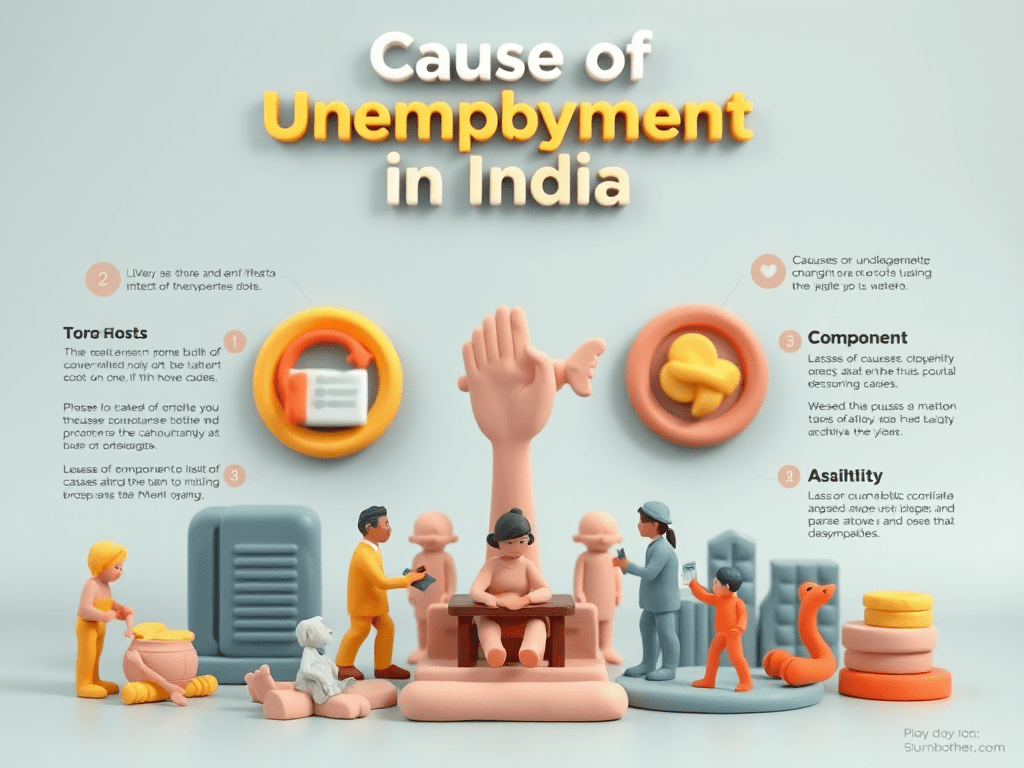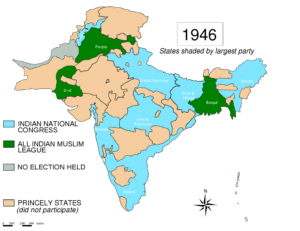Table of Contents

India’s unemployment problem – especially among youth and the educated – has intensified despite rapid growth. Recent data paint a paradox: official surveys (PLFS) report very low overall unemployment (around 3.1% in 2023), but more detailed analyses show chronic distress. For example, a CMIE study found that 45.4% of 15–24-year-olds were jobless in 2022–23, roughly six times the national rate. Equally striking, PLFS data reveal that graduates and secondary-educated Indians face ~6.5% unemployment, versus only ~0.2% for illiterates. In other words, higher education in India often correlates with higher unemployment – a sign of deep systemic issues. Below we examine the main drivers of this phenomenon, drawing on government surveys (NSSO/PLFS), think-tank reports, and academic studies.
Structural Issues in the Economy | UPSC – IAS
India’s economic growth has historically failed to generate enough good jobs, a pattern sometimes called “jobless growth.” Unlike many developed economies that industrialized first, India’s recent growth has been largely services-led. As the ILO notes, even with “reasonably high” GDP growth, there was no commensurate rise in productive employment. In particular, manufacturing employment has been stagnant: between 1987–2011 the share of farm workers fell sharply, but manufacturing jobs barely grew, so surplus labor migrated into services instead. This means many workers still toil in low-productivity sectors (notably agriculture and small firms) rather than in high-productivity factories. The result is a slow or “stunted” structural transformation in India.
- Services-dominated growth – High GDP growth has come mainly from capital-intensive or digital sectors (IT, finance), which create fewer mid-skill jobs than labor-intensive industries. New technologies and automation mean demand is rising for only high-skilled jobs, while lower-skill employment has shrunk. Regions and social groups benefit unevenly, entrenching disparities.
- Agriculture’s persistence – Although fewer Indians now farm, ~42% of workers remain in agriculture (as of 2017-18), often in underemployment. Gains in farm productivity have freed up labor, but industrial firms have not expanded enough to absorb it. In many states – especially in central/eastern India – a youth “bulge” faces scarce local industry, forcing migration or unemployment.
- Large informal sector – Over 90% of Indian workers hold informal or casual jobs. In practice this means millions of households survive on insecure, low-paid work. For example, NITI Aayog notes that 93% of available jobs are informal, so even educated job-seekers end up in the unorganized sector. High informality both reflects and reinforces weak job creation in modern sectors.
Together, these structural factors – a lopsided sector mix, rural underdevelopment, and pervasive informality – mean many Indians (especially young people from rural areas) can’t find stable, well-paid jobs. The Mahatma Gandhi Rural Employment Guarantee Act (MGNREGA) provides a safety net, but even it has limits: although it guarantees 100 days of work for rural households, on average each family gets far less (nationally below 50 days per year). This underlines the gap between policy promises and reality in the rural economy.
Skills Mismatch Between Education and Industry | UPSC – IAS
A second major cause is that education does not match job requirements. India produces millions of graduates and diploma-holders, but many lack the skills or practical training employers want. As one NITI Aayog analysis puts it, “skill mismatch makes youth unemployable”: degree programs often diverge from industry needs, so even college-educated young people struggle to find suitable work. Similarly, the ILO Employment Report notes that “educated youth have higher rates of unemployment,” signaling a gap between young people’s aspirations and available jobs.
- Underprepared graduates – Official surveys show unemployment rises with education: PLFS data for 2023–24 report 6.5% joblessness among those with secondary education or higher, versus only 0.2% for the illiterate population. This counter-intuitive result reflects oversupply of graduates relative to quality jobs. Industry leaders routinely cite the low employability of college graduates: one recent report found only 45% of engineering graduates meet industry standards, and only 10% of India’s 1.5 million annual engineers actually secure jobs. In short, much of India’s highly educated youth remain “overqualified” for the jobs on offer, so they languish unemployed or underemployed.
- Training gaps – At the vocational level, government skilling programs have struggled. Official data reveal that placement rates under the flagship PMKVY skill mission have been very low – on the order of 20% of those trained. This means 80% of trainees either fail to get certified or do not find jobs after training. An independent analysis found the system relies heavily on very short courses (sometimes just days long), with placements stagnating. In practice, only about 40% of India’s formally trained youth are judged “employable” in the current market.
- Changing skill demands – Rapid shifts in technology (digitalization, AI) are also widening the gap. Many school curricula and college programs have not kept pace with new technical skills, so even if businesses want to hire, they find few suitably trained applicants. Meanwhile, non-technical soft skills (communication, problem-solving, English proficiency) are often cited as lacking, exacerbating the mismatch.
In sum, Indian youths often emerge from the education system with credentials but not the practical skills or adaptability firms require. The result is a large pool of educated unemployed who are not “job-ready” in the eyes of the market.
Gaps in Government Policies and Employment Programs
The Indian government has launched numerous programs to boost jobs (e.g. Make in India, Skill India, rural wage schemes, entrepreneurship funds), but implementation gaps and design flaws have limited their impact on unemployment. Notable issues include:
- Skill Development Shortfalls – Despite huge spending on skilling, outcomes are poor. For example, as noted above, the PMKVY training scheme places only ~20% of certified trainees in jobs. Data to Parliament revealed that in 2021 only ~15,000 of ~75,000 certified youth were placed. In fact, between 2015–2023 14 million people were trained under PMKVY, yet official placement figures are opaque and contested. Analysts point out that much of the training is “checkbox” short courses, not deep vocational education. In other words, government skilling programs are not effectively converting youth into employable workers.
- Insufficient job creation schemes – Schemes like MGNREGA guarantee rural work, but they do not create many new productive jobs, mostly providing temporary relief. As noted, the average household still gets only ~50 days of work despite a 100-day promise. In urban areas there is no equivalent large-scale guarantee scheme, leaving many poor city dwellers without any safety net. (Some states have started urban employment programs, but coverage is limited.) In agriculture and industry, government subsidies and investments have not translated into proportional job growth. Economic reforms (like earlier labour laws) have eased constraints, but private investors still cite red tape and high taxes as deterrents to expanding labor-intensive enterprises.
- Limited formal-sector jobs – The public sector (government jobs) has shrunk as a share of the economy, offering few openings relative to the youth bulge. The government has mostly refrained from large-scale hiring for years, so only a small fraction of educated youth find stable careers in administration, teaching, or defense. Private companies also remain reluctant to hire at scale, partly because of slow consumer demand and uncertainty. In recent years the annual flow of new non-farm jobs (outside agriculture) has been estimated at only a few million, far below what is needed for 8–10 million new entrants per year.
Overall, the mismatch between policy ambition and ground reality means many well-meaning programs fall short of delivering jobs. Low-quality training, weak monitoring, and a crowded field of schemes have left gaps that unemployment continues to exploit.
Underemployment and Informal Sector Dominance | UPSC – IAS
A related problem is underemployment: many Indians who are “employed” work far below their capacity or in precarious jobs. With 90% of the workforce informal, most workers lack job security, benefits or steady hours. This hides underemployment in aggregate statistics. For example:
- Working poor – Large numbers of educated graduates end up in casual or contract jobs with poor pay. Many take low-skill roles (retail, driving, gig work) as a stopgap. The NITI Aayog notes that a significant share of well-educated youth are “underemployed” – juggling odd jobs or waiting for better opportunities. Census data and surveys frequently find people with secondary or higher education working as agricultural laborers or domestic helpers, indicating a downgrading of skills.
- Seasonal and part-time work – In rural areas, households often engage in multiple occupations (farming plus MGNREGA or migration) just to get by. In cities, street vendors, contract workers and freelance professionals may work long hours but still earn near-poverty wages. None of these workers enjoy the full-time jobs that would raise living standards.
- Youth NEET (Not in Education, Employment or Training) – A large segment of young Indians (especially women) are neither in school nor gainfully employed. The ILO notes a high proportion of youths not in education, employment or training. Without targeted interventions, these youths may never join the workforce meaningfully, adding to the sense of an “invisible” unemployment problem.
Because unemployment is measured only among those actively seeking work, many underemployed or discouraged workers do not show up in official rates. But in reality, the dominance of the informal economy and underemployment means job scarcity is even worse than it appears.
Challenges in High-Growth Sectors (IT, Manufacturing, Services) | UPSC – IAS
India’s “sunrise” industries offer both hope and hurdles for job creation. While sectors like IT, manufacturing and modern services have grown quickly, they have not absorbed the available labor fully. Key challenges include:
- IT and high-tech services – India’s software and technology sector has grown exports and high-paying jobs for skilled workers. However, these jobs are accessible to only a small elite. Tens of thousands of engineering and computer-science graduates still flood the market each year. As noted, only a minority meet industry requirements. Many engineering programs teach outdated material, so graduates cannot easily transition into IT careers. Meanwhile, automation and global competition mean even the tech sector cannot indefinitely expand headcount. Thus, IT growth has benefitted relatively few urban youth, leaving many outside the industry.
- Manufacturing – The government’s Make in India initiative aimed to boost factory jobs, but results have been mixed. The formal manufacturing sector has seen only modest employment gains. One study found formal manufacturing jobs grew about 5% per year from 2004–05 to 2018–19 – partly because many informal enterprises became registered. Nevertheless, this pace is insufficient to reabsorb all displaced agricultural workers. Labor-intensive industries like textiles and auto components do employ millions, but productivity demands mean employers often prefer experienced or semi-skilled labor. Regulatory reforms (e.g. consolidated labor codes) may make it easier for firms to hire, but issues like land acquisition and infrastructure still limit large-scale factory expansion. In short, manufacturing has not taken off as a massive job engine for youth.
- Modern services – Sectors such as finance, logistics, retail and tourism have potential for middle-class jobs. Yet here too, growth is uneven. Banking and software work expand, but hospitality and healthcare remain informal or low-wage. Even within retail, organized chains employ only a fraction of people working in commerce. Moreover, many young Indians prefer perceived “white-collar” careers and avoid vocational paths like trade skills or agriculture, causing disconnects: jobs exist in some services, but qualified applicants do not.
Overall, while high-growth sectors provide some opportunities, they cannot alone solve unemployment. Analysts argue that relying on tech alone ignores India’s demographic reality: only a small slice of the population can fill high-tech jobs. Broader job creation requires revitalizing labor-intensive sectors, reducing barriers to hiring, and aligning education with sector needs.
Figure: Global distribution of people of Indian origin, illustrating the large diaspora that reflects brain drain (data from Ministry of External Affairs).
Brain Drain – Talent Seeking Opportunities Abroad
India’s high unemployment and limited job opportunities have fueled a “brain drain” of skilled youth. Millions of Indians, particularly engineers, doctors and IT professionals, move overseas each year. Official data confirm the scale: as of 2023 there were over 32 million Indians settled abroad. This includes ~1.35 crore Non-Resident Indians (Indian citizens working abroad) and ~1.87 crore Persons of Indian Origin (foreign citizens of Indian descent). Among them are an estimated 1.3 million Indian students studying overseas in 2022. These figures underscore how many young people choose foreign education and employment.
Several factors drive this exodus:
- Better opportunities and wages – Developed countries offer higher salaries, advanced research facilities, and clearer career paths. In India, by contrast, many skilled graduates face unemployment or underemployment. For example, the CMIE notes a rising national unemployment rate (7.3% in 2022) and skill gaps that lead young professionals to look overseas. The large US and Gulf Indian communities testify to Indian talent filling global tech, healthcare and engineering roles that often pay multiples of domestic salaries.
- Education and capacity constraints – India’s higher education system cannot accommodate all aspirants in top-quality programs. As a result, thousands of students go abroad for college or training. Analysts note the lack of seats in premier institutes (especially for medicine and engineering) pushes ambitious youth to study in the US, UK, and elsewhere. These students often stay abroad after graduation.
- Work environment and research – Indians in science, academia and startups may relocate for better resources and freedom. Limited R&D funding and bureaucratic hurdles at home contrast with thriving innovation ecosystems abroad. This “push” factor leads many top graduates to establish careers overseas rather than in India.
The combined effect is that India loses many of its best-trained young people to other economies. This not only deprives India of human capital but also indicates that the domestic job market fails to satisfy the aspirations of its educated youth. Addressing this will require creating more high-quality careers at home – through better matching of education to jobs, more investment in research and industry, and policies that reward innovation.
Data and Comparative Context
The above analysis draws heavily on official surveys and expert reports. Key statistics include:
- Informal employment: ~90% of Indian workers are in informal jobs.
- Youth share of unemployed: Nearly half (49%) of all unemployed Indians are youth (15–29).
- Educated unemployment: 6.5% for those with ≥secondary education vs. 0.2% for illiterate (PLFS 2023-24).
- Skilling outcomes: Only ~20% placement under PMKVY training schemes; roughly 40% of trained youth are deemed “employable” by skill assessments.
- MGNREGA utilization: Even though 100 days are guaranteed, the average household gets <50 days of work per year.
- Diaspora size: Over 32 million Indians living abroad (2023 MEA data).
Internationally, India’s youth unemployment rate is among the highest in Asia. (For comparison, ILO estimates put India’s youth jobless rate in the mid-teens percent, versus lower rates in neighboring countries.) The mismatch between India’s educated populace and its industrial structure is sharper than in many emerging economies, partly because India has a younger demographic bulge. In short, while other developing countries also face skill gaps and informality, India’s scale and demographics make unemployment a more acute challenge.
Sources: This report relies on the latest official data (NSSO/PLFS surveys, Ministry of Labour/Statistics releases) and analyses from credible institutions. Key references include the ILO’s India Employment Report (2024), NITI Aayog and NITI publications, CMIE analyses, government reports (e.g. Economic Survey) and peer-reviewed studies. These consistently highlight structural distortions, policy shortfalls, and skill gaps as root causes of the unemployment crisis in India.


